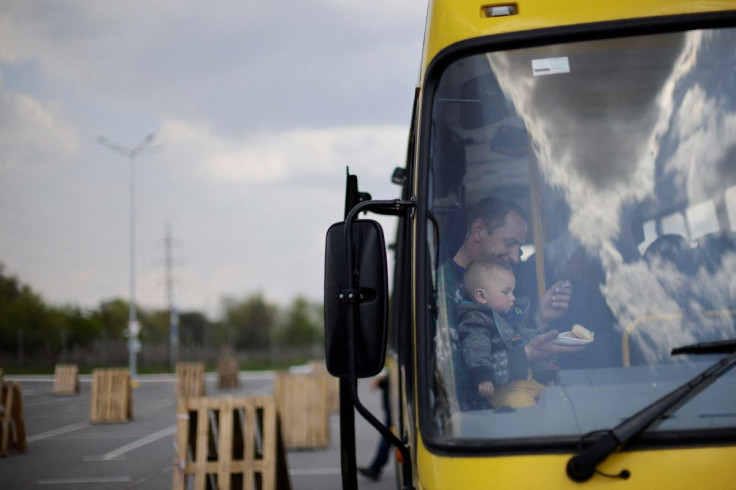Exhausted Evacuees From Mariupol Steel Plant Reach Safety In Ukrainian City

Dozens of evacuees who cowered for weeks in the bunkers of a steel works in Russian-occupied Mariupol reached the safety of Kyiv-controlled Zaporizhzhia on Tuesday where hospitals were ready to treat people for anything from burns to malnutrition.
Exhausted-looking people, including young children and pensioners laden with bags, clambered off buses that pulled into the car park of a shopping center in Zaporizhzhia in southern Ukraine not far from the front lines.
More than 200 civilians remain in the Azovstal steel plant, according to Mariupol Mayor Vadym Boichenko, with a total of 100,000 civilians still in the city that has been devastated by weeks of Russian siege and shelling.
"Thanks to the operation, 101 women, men, children, and older persons could finally leave the bunkers below the Azovstal steelworks and see the daylight after two months," Osnat Lubrani, U.N. humanitarian coordinator for Ukraine, said.
The sprawling Azovstal industrial complex and its many bunkers and tunnels became a refuge for both civilians and Ukrainian fighters as Moscow laid siege to Mariupol.
The United Nations and International Committee of the Red Cross (ICRC) coordinated the five-day operation that began on April 29 to bring out women, children and the elderly from the steel works.
Other families and individuals from outside the steel works joined the convoy of buses and ambulances on its way, the ICRC said.
"I can't believe I made it, we just want rest," said Alina Kozitskaya, who spent weeks sheltering in a basement with her bags packed waiting for a chance to escape.
One middle-aged woman walked away from the evacuation bus sobbing. She was comforted by an aid worker.
A few women who greeted the convoy held up handmade signs, calling on Ukrainian authorities to evacuate the soldiers - their relatives and loved ones - who are trapped in Azovstal and encircled by Russian forces.
"We're scared that after the evacuation of civilians, the guys will be left there. We don't see any sign of help," said Ksenia Chebysheva, 29, whose husband is among Azov Regiment troops there.
Chebysheva, who held up a sign in English saying "Save the Military from Azovstal", said she had heard that her husband was still alive on April 26 but had had no news since.
"They don't have food, water or ammunition," shouted another woman. "They're forgotten by everyone."
SOME REMAIN IN MARIUPOL
Hospitals had been stocked up and supported by volunteers to prepare for the arrival of the convoy, Dr Dorit Nizan, World Health Organization (WHO) Incident Manager for Ukraine, said by Zoom from Zaporizhzhia.
"We are ready for... burns, fractures and wounds, as well as diarrhoea, respiratory infections. We are also ready to see if there are pregnant women, children with malnutrition. We are all here and the health system is well prepared," she said.
She said some people had arrived recently by making their own way from villages near Mariupol and had minor injuries, but that mental health was the "big issue".
"Many cried when they arrived when they were met by family members. It was very moving," she said.
In Mariupol, 64-year-old resident Tatyana Bushlanova is so used to Russian bombardments that she does not flinch when shells explode.
"You wake up in the morning and you cry. You cry in the evening. I don't know where to go at all... everything is destroyed, everything is broken," Bushlanova said on Monday, wiping away tears on a bench outside a charred apartment block.
"It does not stop. I don't know how to stay here during the winter. We don't have a roof, don't have windows. Everything is very complicated."
© Copyright Thomson Reuters 2024. All rights reserved.







